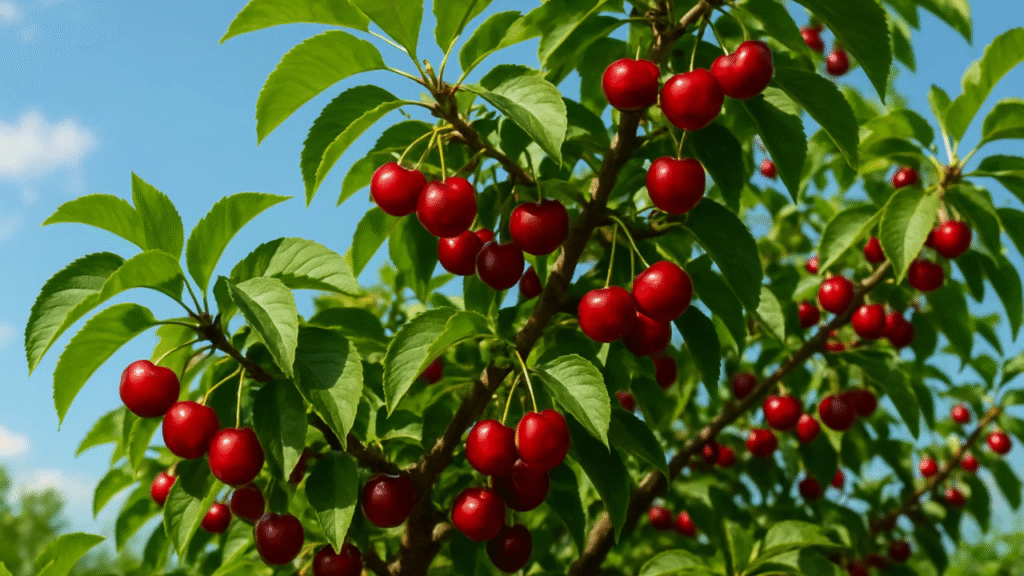
The Best Cherry Tree Fertilizers for Optimal Growth: Expert Guide & Tips
If you’re a proud cherry tree owner, you know how rewarding it can be to watch your tree thrive and bear fruit 🍒. But, like all plants, cherry trees need the right care to reach their full potential. One of the most important factors for healthy growth is choosing The Best Cherry Tree Fertilizers for Optimal Growth: Expert Guide🌱. Fertilizing your cherry tree correctly ensures it gets the essential nutrients it needs for strong roots, lush leaves, and, of course, delicious fruit. In this guide, we’ll break down the top fertilizer options, application tips, and expert advice to help you nurture your cherry tree to its best potential. Let’s dive in!
Table of Contents
ToggleUnderstanding the Nutrient Needs of Cherry Trees 🌳
Cherry trees thrive when they receive the right balance of nutrients. These nutrients are essential for their growth, flowering, and fruit production 🍒. Here’s a breakdown of what your cherry tree needs:
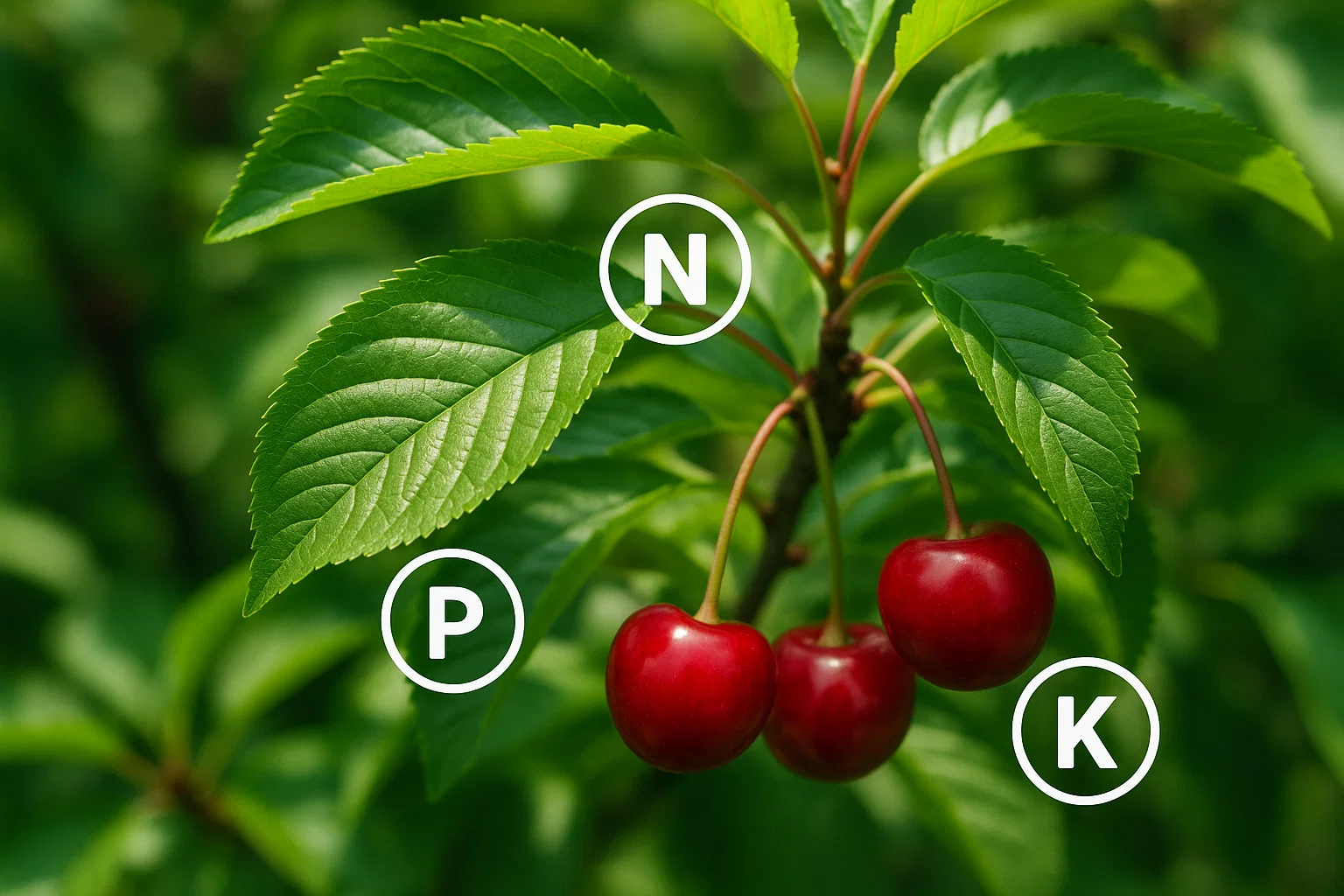
Nitrogen (N) 🌿
This is crucial for healthy leaf and stem growth. It helps your tree build strong foliage, which is vital for photosynthesis and overall vitality.
Phosphorus (P) 🌸
Phosphorus supports root development and flower production. It’s especially important during the tree’s early stages of growth to establish a strong foundation.
Potassium (K) 🍏
Potassium helps the tree withstand stress, improves disease resistance, and boosts fruit quality. It’s key for producing sweeter, healthier cherries.
Micronutrients 🌱
In addition to these primary nutrients, cherry trees also need small amounts of other nutrients like calcium, magnesium, and sulfur. These help with cell wall strength, enzyme activation, and overall plant health.
By ensuring your cherry tree gets these nutrients, you’ll enjoy lush greenery and bountiful fruit production 🍒. Fertilizing with the right mix of these elements will give your cherry tree everything it needs to flourish! 🌱
Signs Your Cherry Tree Needs Fertilizer 🌿❗
Not sure if your cherry tree needs a nutrient boost? Your tree will often tell you when it’s hungry! 🍒 Here are some clear signs to watch for:
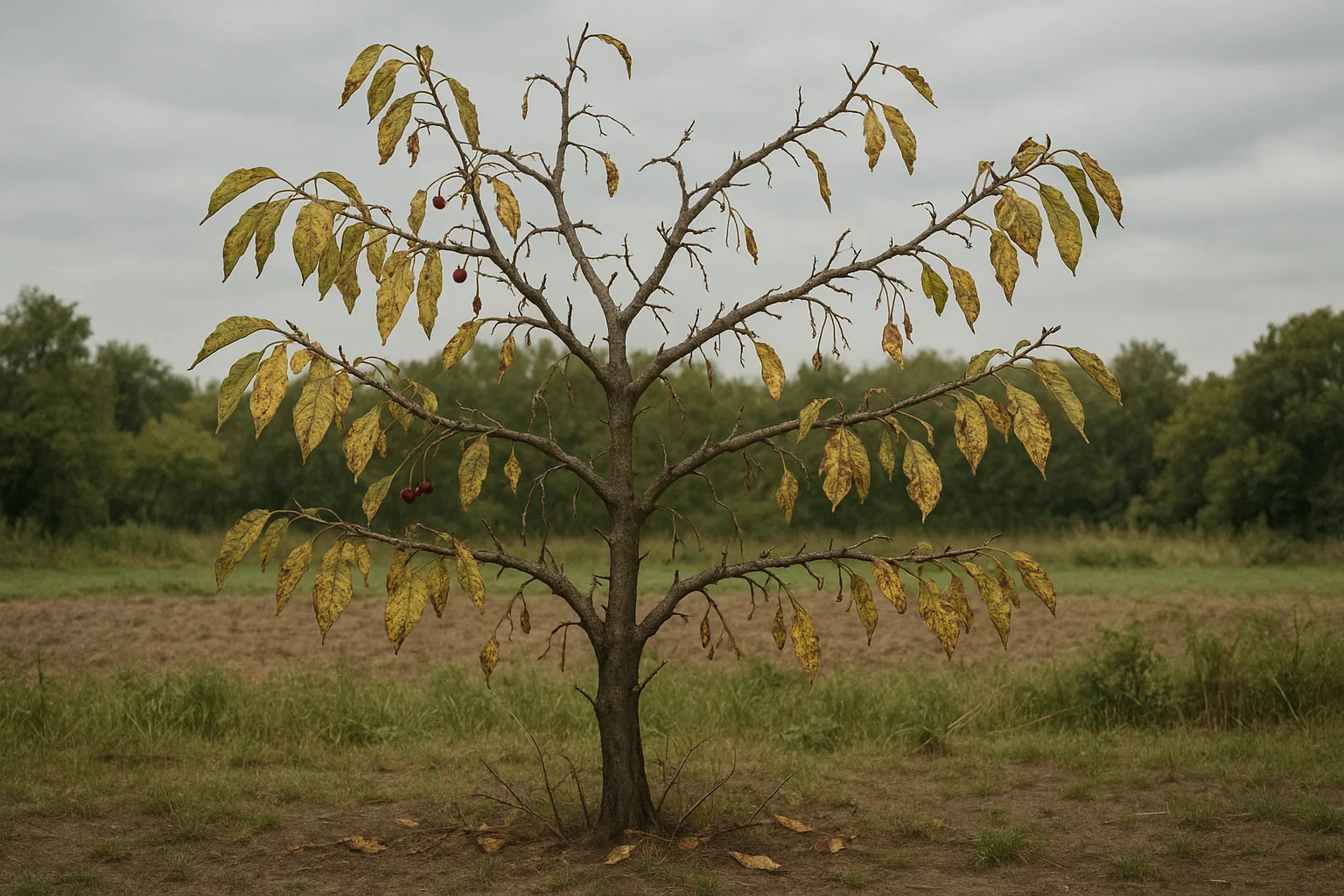
- Yellowing Leaves 💛: If the leaves are turning pale or yellow—especially the older ones—it could be a nitrogen deficiency.
- Slow or Stunted Growth 🐢: Is your tree not growing much this season? Lack of key nutrients can slow down branch and leaf development.
- Few or No Blossoms 🌸🚫: Poor blooming can signal a phosphorus shortage, which affects flowering and fruiting.
- Small or Poor-Quality Fruit 🍒😞: If your cherries are tiny, sour, or falling off early, your tree might be low on potassium.
- Leaf Curling or Browning 🍂: These symptoms may point to a lack of micronutrients or stress from underfeeding.
- Weak Branches or Sparse Foliage 🌬️: A thin canopy or droopy limbs can indicate the tree isn’t getting the nutrients it needs for strength and structure.
🌱 Tip: If you’re seeing these signs, it’s a good time to test your soil and consider applying fertilizer. A well-fed cherry tree is a happy one—and it will reward you with lush leaves and juicy fruit! 🍒
Types of Fertilizers for Cherry Trees 🌿✨
When it comes to fertilizing your cherry tree, choosing the right type of fertilizer can make all the difference! Let’s break down the most popular options:
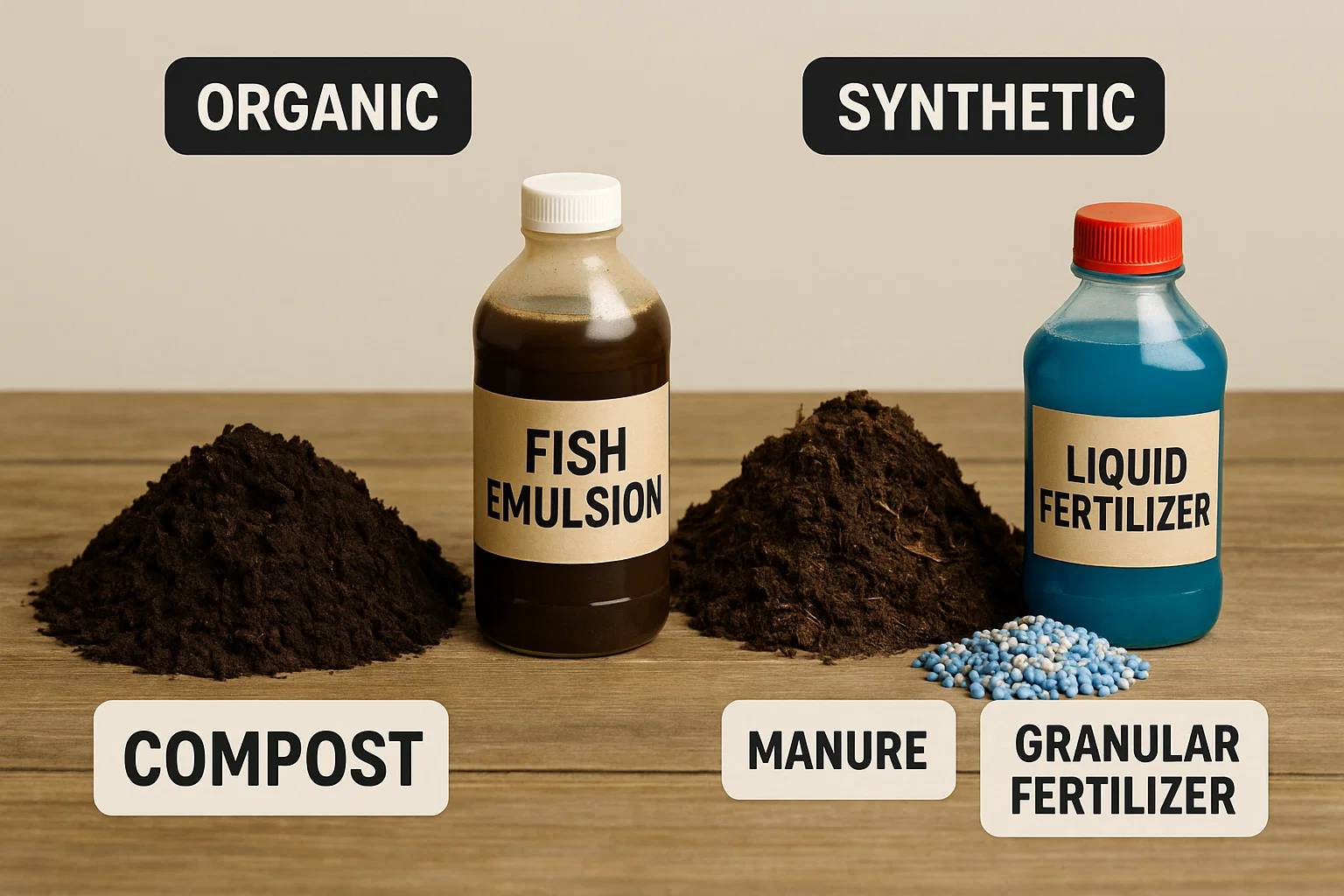
Organic Fertilizers 🌱
- Compost: A natural, slow-release option that enriches the soil with organic matter. It improves soil structure and helps retain moisture 💧. Great for long-term soil health!
- Fish Emulsion: Made from fish by-products, this liquid fertilizer is rich in nitrogen and boosts leaf growth 🌿. It’s gentle, fast-acting, and great for getting quick results!
- Manure: Well-aged manure provides a steady supply of nutrients over time 🐄. It’s an eco-friendly option that adds both nutrients and beneficial microbes to the soil.
Synthetic Fertilizers ⚡
- Granular Fertilizers: These slow-release pellets (like 10-10-10) provide balanced nutrients over time. They’re easy to apply and perfect for regular feeding 🌾.
- Liquid Fertilizers: Fast-acting and absorbed quickly by the tree, liquid fertilizers are great for a quick nutrient boost. They’re ideal for when you need rapid growth or to address a deficiency 🍃.
Slow-Release vs. Quick-Release 🕑⚡
- Slow-Release: Gradually releases nutrients, feeding your tree for months. Perfect for long-term growth and minimizing the risk of over-fertilizing.
- Quick-Release: Delivers nutrients fast! It’s great for immediate results, but you’ll need to apply it more often.
Choosing the right fertilizer depends on your tree’s specific needs and how much time you have to tend to it. Organic options are great for gardeners looking for natural, long-term solutions, while synthetic fertilizers offer quicker results. 🌱💪
Top Picks for Cherry Tree Fertilizers 🍒🌟
Choosing the right fertilizer for your cherry tree can be overwhelming with so many options out there. Here are some of the best choices, whether you’re looking for organic, synthetic, or a balanced mix!
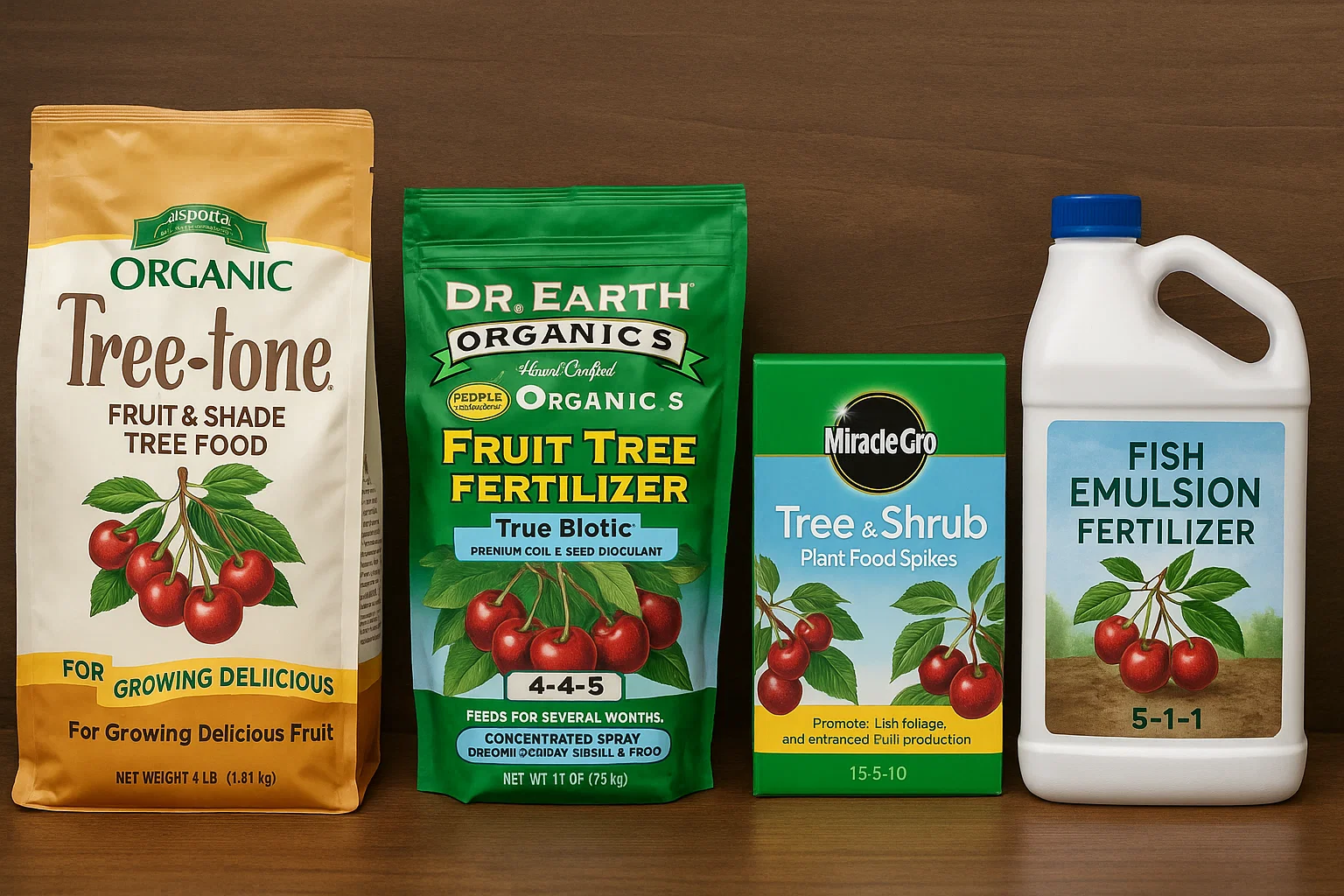
Organic Fertilizer Options 🌿
- Espoma Tree-Tone: A well-known organic fertilizer designed specifically for fruit trees. It contains a balanced mix of nitrogen, phosphorus, and potassium, along with beneficial microbes to improve soil health 🌱. Perfect for healthy growth and bountiful fruit!
- Dr. Earth Organic 5: This is a top-rated organic fertilizer that provides an excellent blend of nutrients for cherry trees. It’s made with fish meal, seaweed extract, and other natural ingredients 🌊. It promotes vibrant growth and sweet, juicy cherries.
- Fish Emulsion (Neptune’s Harvest): If you’re looking for a fast-acting organic option, fish emulsion is ideal. It’s rich in nitrogen, making it perfect for boosting leaf and stem growth 🍃. Great for younger trees or those needing a quick nutrient boost!
Synthetic Fertilizer Options ⚡
- Miracle-Gro Water Soluble All Purpose Plant Food: This popular synthetic fertilizer provides a quick nutrient boost, especially during the growing season. It’s water-soluble and easy to apply with a watering can 💧. Perfect for vibrant, green foliage and strong fruit production.
- Jobe’s Organic Fertilizer Spikes: These spikes are an easy, no-mess option for feeding your cherry tree. Packed with essential nutrients, they release slowly over time, making them a convenient choice for busy gardeners 🌿.
- Osmocote Smart-Release Plant Food Flower & Vegetable: This slow-release fertilizer is great for cherry trees that need a steady nutrient supply. It’s perfect for keeping your tree healthy throughout the growing season 🌸🍒.
Specialized Cherry Tree Fertilizers 🍒
- Fruit Tree Fertilizer by Down to Earth: Specifically formulated for fruit trees, this organic blend includes the perfect mix of nutrients to encourage healthy blossoms and delicious fruit 🍏🍒. It’s rich in potassium, which helps promote strong fruiting.
Final Tip:
Always choose a fertilizer that matches the growth stage of your cherry tree. Younger trees need a different mix than mature ones, so be sure to check the label for recommendations! 🌱 For expert suggestions and reliable products, check out The Best Cherry Tree Fertilizers for Optimal Growth: Expert Guide to make the right choice for your tree.
How to Apply Fertilizer to Cherry Trees 🌳💧
Proper application of fertilizer is key to ensuring your cherry tree thrives. Here’s a simple guide to help you fertilize effectively:
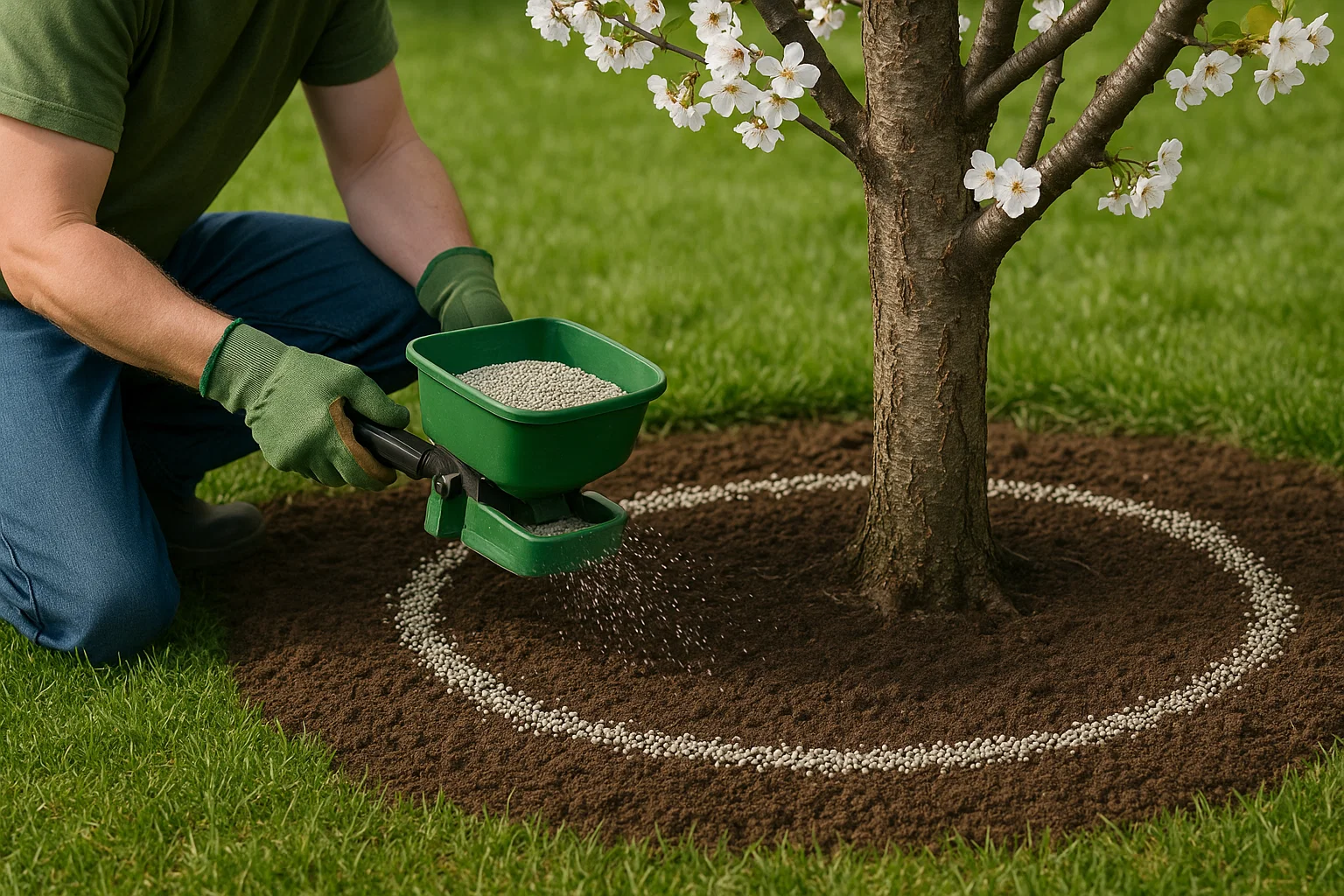
1. Choose the Right Time 🕒
- Early Spring: Apply fertilizer in early spring, just before the growing season begins, to kickstart growth.
- After Blooming: For a second boost, fertilize again after the tree has bloomed, ensuring it has enough nutrients to produce healthy fruit 🍒.
- Avoid Late Fall: Don’t fertilize too late in the season, as it can encourage new growth that may not survive the winter ❄️.
2. Apply Fertilizer Properly ✨
- Granular Fertilizers: Spread granular fertilizer evenly around the base of the tree, starting a few inches from the trunk and extending outward to the tree’s drip line (where the branches end). This ensures the roots can absorb the nutrients effectively.
- Liquid Fertilizers: For liquid fertilizers, mix as directed and apply directly to the soil around the tree’s base using a watering can or hose attachment 💦. Be sure the liquid reaches the root zone.
3. Correct Dosage 📏
- Follow Instructions: Always follow the manufacturer’s instructions for the correct amount. Too little won’t be effective, while too much can harm your tree or burn the roots ⚠️.
- Young vs. Mature Trees: Younger trees need smaller amounts of fertilizer, while established trees may need a higher dose.
4. Water After Applying 💦
After applying fertilizer, water your tree thoroughly to help the nutrients reach the roots. This also prevents fertilizer burn and helps the soil absorb the nutrients efficiently 🌱.
5. Repeat as Needed 🔄
For granular fertilizers, a single application per year may be enough, but liquid fertilizers may need reapplication every 4-6 weeks during the growing season.
By applying fertilizer correctly, you’ll ensure your cherry tree stays strong, healthy, and ready to produce beautiful fruit 🍒! For guidance on choosing and using the right products, refer to The Best Cherry Tree Fertilizers for Optimal Growth: Expert Guide.
Additional Tips for Cherry Tree Health 🌳💚
In addition to fertilizing, there are a few simple yet important steps you can take to keep your cherry tree in top shape. Here are some extra tips to ensure it thrives:
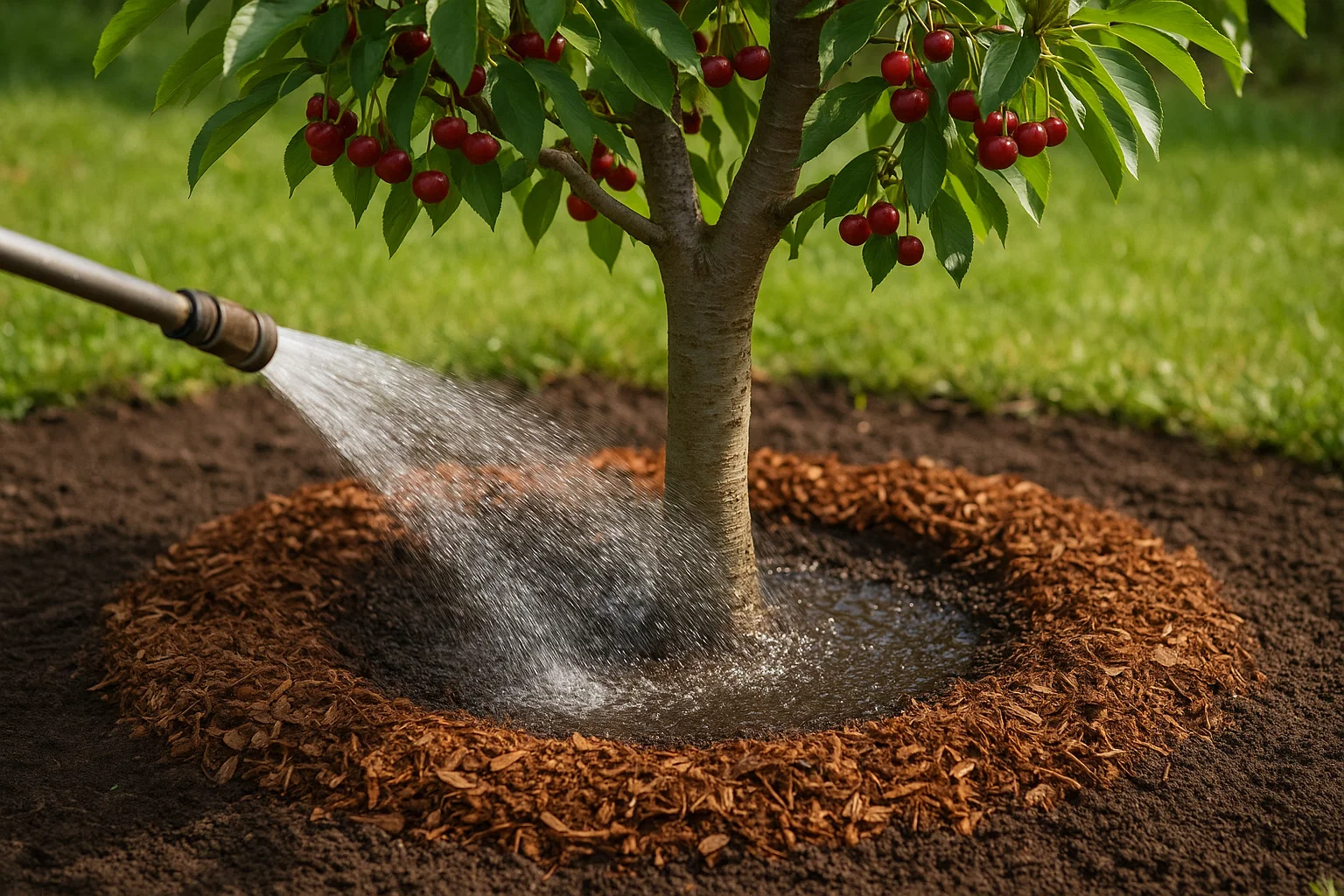
1. Watering 💧
Cherry trees need consistent watering, especially during dry periods. Make sure the soil is moist but not soggy. Water deeply at the tree’s base, allowing the roots to absorb the moisture. 🌧️
2. Pruning ✂️
Prune your cherry tree regularly to remove dead or damaged branches. This promotes air circulation and sunlight penetration, both of which are essential for healthy growth. Pruning also helps the tree focus its energy on strong branches and fruit production 🍒.
3. Mulching 🌾
Mulch around the base of your tree to retain moisture, regulate soil temperature, and reduce weeds. Use organic mulch like wood chips or straw, but make sure to keep it away from the tree’s trunk to avoid rot. 🌱
4. Soil Testing 🧪
Test your soil annually to check for nutrient deficiencies or imbalances. Soil testing helps you tailor your fertilizing schedule and ensure your cherry tree is getting exactly what it needs for healthy growth and fruiting 🌾.
5. Pest and Disease Control 🐞🚫
Monitor your tree for signs of pests like aphids or diseases like powdery mildew. Treat early to prevent damage and ensure your cherry tree remains healthy. Natural remedies like neem oil or insecticidal soap can be effective and safe alternatives to chemical pesticides.
6. Seasonal Care 🍂🌸
- Winter Protection: In colder climates, protect your cherry tree in the winter by wrapping the trunk with burlap to prevent frost damage.
- Spring Prep: As the weather warms up, remove any winter protection and start prepping your tree for the growing season.
By combining these care tips with proper fertilization, your cherry tree will be strong, healthy, and ready to produce delicious fruit year after year! 🌳🍒 For more insights on effective feeding, don’t miss The Best Cherry Tree Fertilizers for Optimal Growth: Expert Guide.
Common Mistakes to Avoid When Fertilizing Cherry Trees ⚠️🌿
Fertilizing is essential, but it’s easy to make mistakes that could harm your cherry tree. To avoid these issues and choose the right nutrients, explore The Best Cherry Tree Fertilizers for Optimal Growth: Expert Guide for reliable guidance. Here’s a list of common fertilizing errors to avoid:
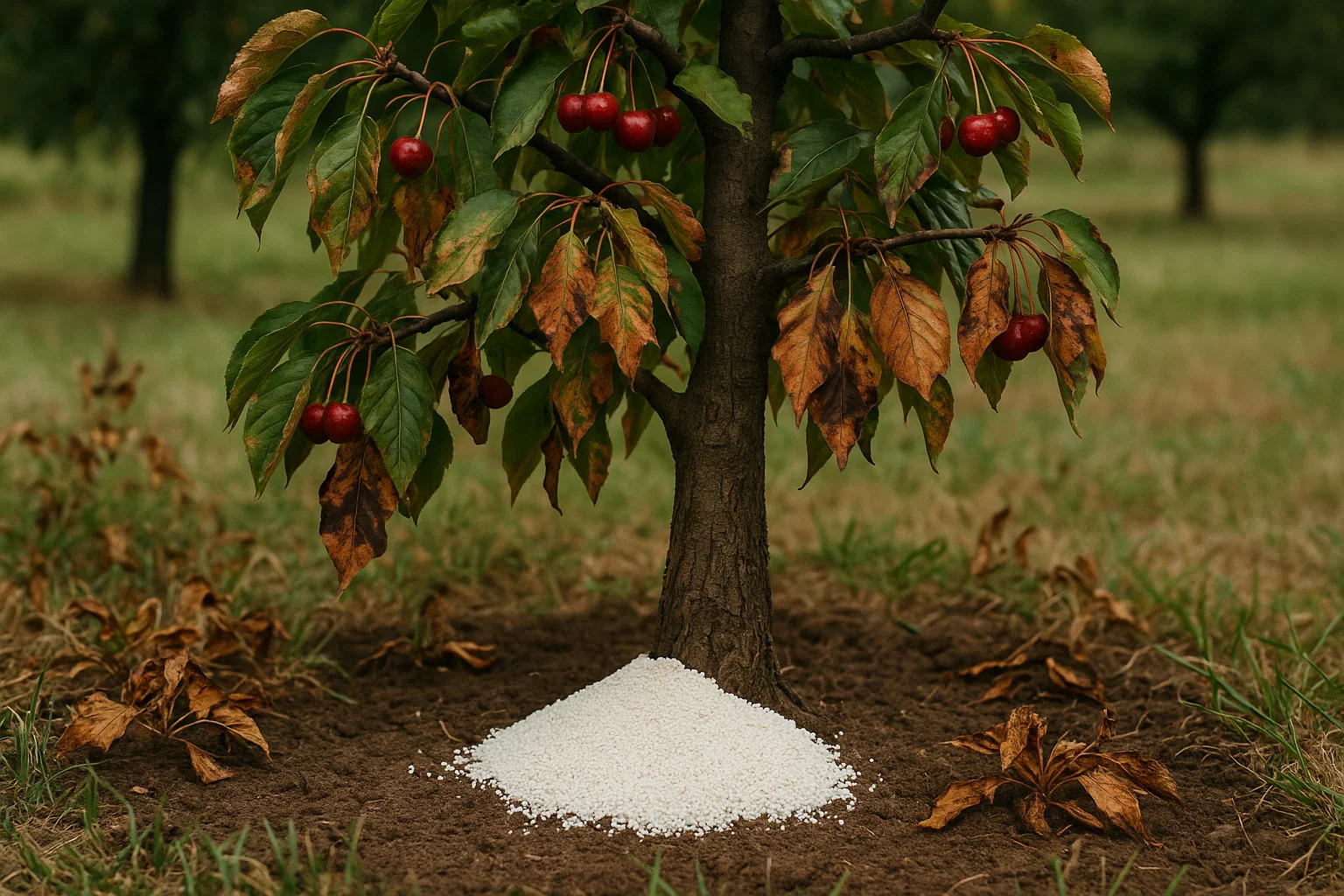
1. Over-Fertilizing 🌱❌
Adding too much fertilizer can burn your tree’s roots, damage its growth, and even harm the soil. Always follow the recommended dosage on the fertilizer label. Less is often more when it comes to feeding your tree!
2. Using the Wrong Fertilizer 🚫
Not all fertilizers are suitable for cherry trees. Be sure to choose a balanced mix with the right nutrients—look for fertilizers with a mix of nitrogen, phosphorus, and potassium (N-P-K) that matches your tree’s needs. Avoid using high-nitrogen fertilizers meant for lawn care, as they can promote excessive leaf growth at the expense of fruiting.
3. Fertilizing at the Wrong Time ⏰
Timing matters! Fertilizing too early, especially in the fall, can encourage growth that’s vulnerable to winter damage. Similarly, fertilizing too late in the growing season can cause late-season growth that won’t harden off before the cold sets in. Stick to early spring or post-bloom applications for the best results.
4. Applying Fertilizer Too Close to the Tree Trunk 🌳
When applying granular fertilizer, don’t pile it directly around the trunk. This can cause root burn. Spread the fertilizer around the drip line (the area directly under the branches) to ensure the roots get the nutrients they need without harming the tree.
5. Ignoring Soil Health 🌍
Fertilizer alone isn’t enough. Cherry trees thrive in well-drained, slightly acidic soil. Be sure to monitor your soil’s pH and texture. If your soil is too compacted or alkaline, fertilizing won’t be as effective. Consider adding organic matter or adjusting pH if needed.
6. Forgetting to Water After Fertilizing 💦
Watering helps distribute the nutrients into the soil, ensuring the roots can absorb them. Always water your cherry tree well after applying fertilizer to avoid fertilizer burn and ensure the nutrients reach the roots.
By avoiding these common mistakes, you’ll set your cherry tree up for healthy growth, stunning blossoms, and sweet, juicy fruit 🍒!
Final Thoughts 🌟🌳
Caring for your cherry tree takes time, attention, and the right approach. By following the proper fertilizing techniques, managing soil health, and avoiding common mistakes, you can ensure your tree grows strong, healthy, and ready to produce delicious fruit 🍒.
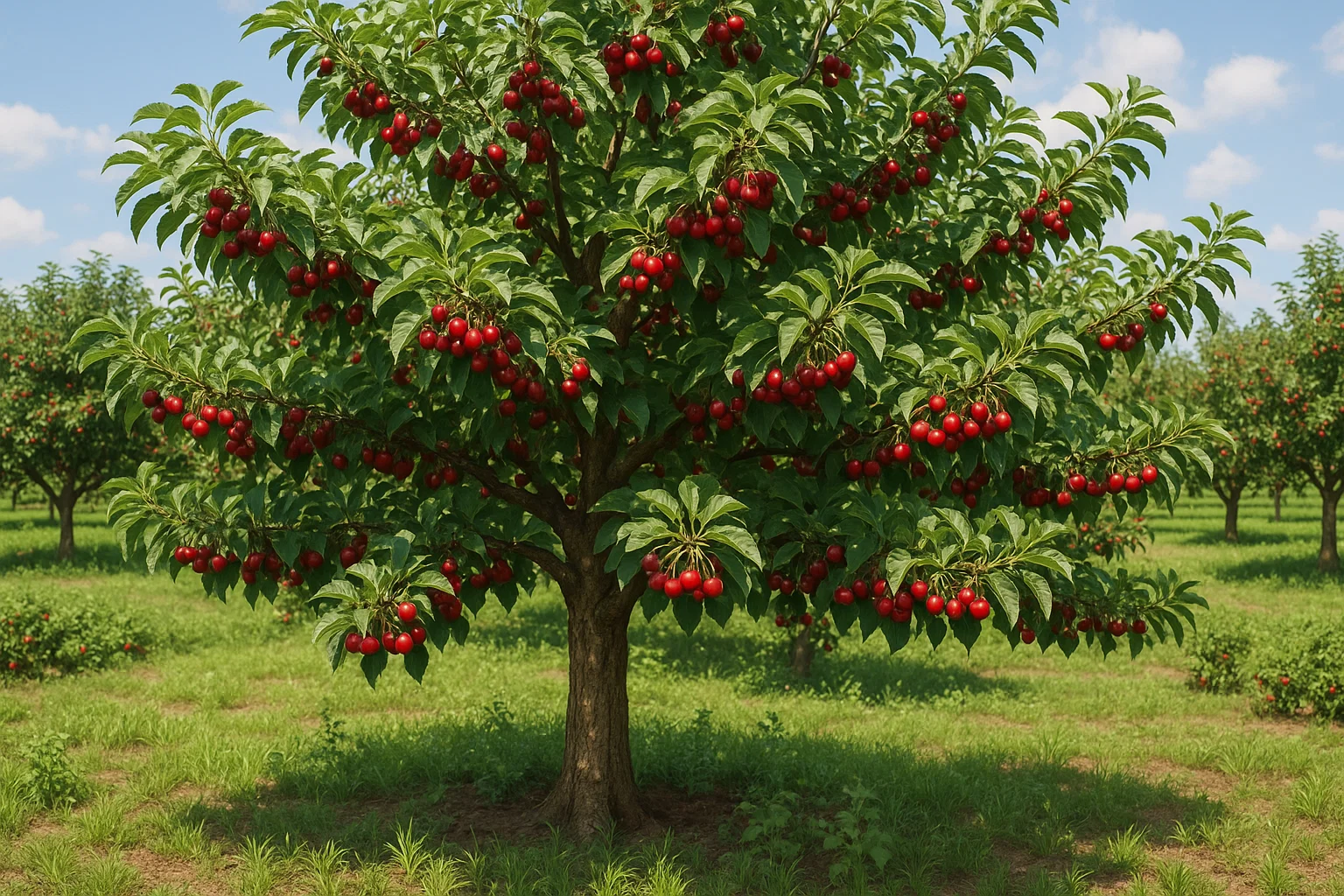
Remember, it’s not just about feeding your tree but also about providing the right conditions for it to thrive year-round. With a little effort, your cherry tree will reward you with vibrant leaves, beautiful blossoms, and bountiful harvests. 🌱💚
Stay proactive, keep nurturing your tree, and enjoy the process of growing a fruitful and thriving cherry tree! 🌳🍒
Frequently Asked Questions (FAQ)
What is the best fertilizer for cherry trees?
The best fertilizers for cherry trees are balanced, slow-release types like 10-10-10 or organic options like compost and well-aged manure.
When should I fertilize my cherry tree?
Fertilize your cherry tree in early spring before new growth begins, and again in late summer to support healthy fruit development.
Can I use chemical fertilizers on cherry trees?
Yes, chemical fertilizers can be used, but organic options like compost are preferred for long-term soil health and sustainability.
How often should I fertilize my cherry tree?
Cherry trees typically need fertilization once a year in early spring, though young trees may benefit from additional feeding in late summer.
Is there a special fertilizer for fruiting cherry trees?
Fertilizers high in potassium and phosphorus support fruiting cherry trees, encouraging healthy blossoms and fruit production.
Can over-fertilizing harm my cherry tree?
Yes, over-fertilizing can lead to excessive growth, weak branches, and increased susceptibility to diseases. Always follow recommended amounts.
Should I fertilize my cherry tree if it's not bearing fruit?
If your cherry tree isn’t bearing fruit, ensure it gets balanced fertilizer and review care practices. Lack of fruit may also be due to other factors like insufficient sunlight or water.
Can I use a liquid fertilizer on cherry trees?
Yes, liquid fertilizers are an effective option for cherry trees, especially during the growing season, as they are absorbed quickly and provide fast results.
